This is the website of Abulsme Noibatno Itramne (also known as Sam Minter).
Posts here are rare these days. For current stuff, follow me on Mastodon
|
Once again the headline out of a state is Trump winning. In Nevada the delegate count was:
14 Trump, 7 Rubio, 6 Cruz, 2 Carson, 1 Kasich
To be on the glide path for a 1st ballot victory though, Trump needed 15 of the 30 delegates. So he fell slightly short.
Now, don’t misunderstand. This is still an impressive victory, and looking at the upcoming states he has a clearer path to victory than anybody else. His margins were higher in Nevada than many people expected. But if today’s performance was replicated in all of the other states, Trump would come to the convention with more delegates than anybody else, but not the majority needed to win outright. Of course as we continue more people will drop out, and the amount with which states give bonuses to the winners increases, so that still seems like an unlikely final outcome.
Right now Trump continues to do everything he needs to do to win. Lets look at some of the graphs, then we’ll do a quick look at the March 1st “Super Tuesday” states.
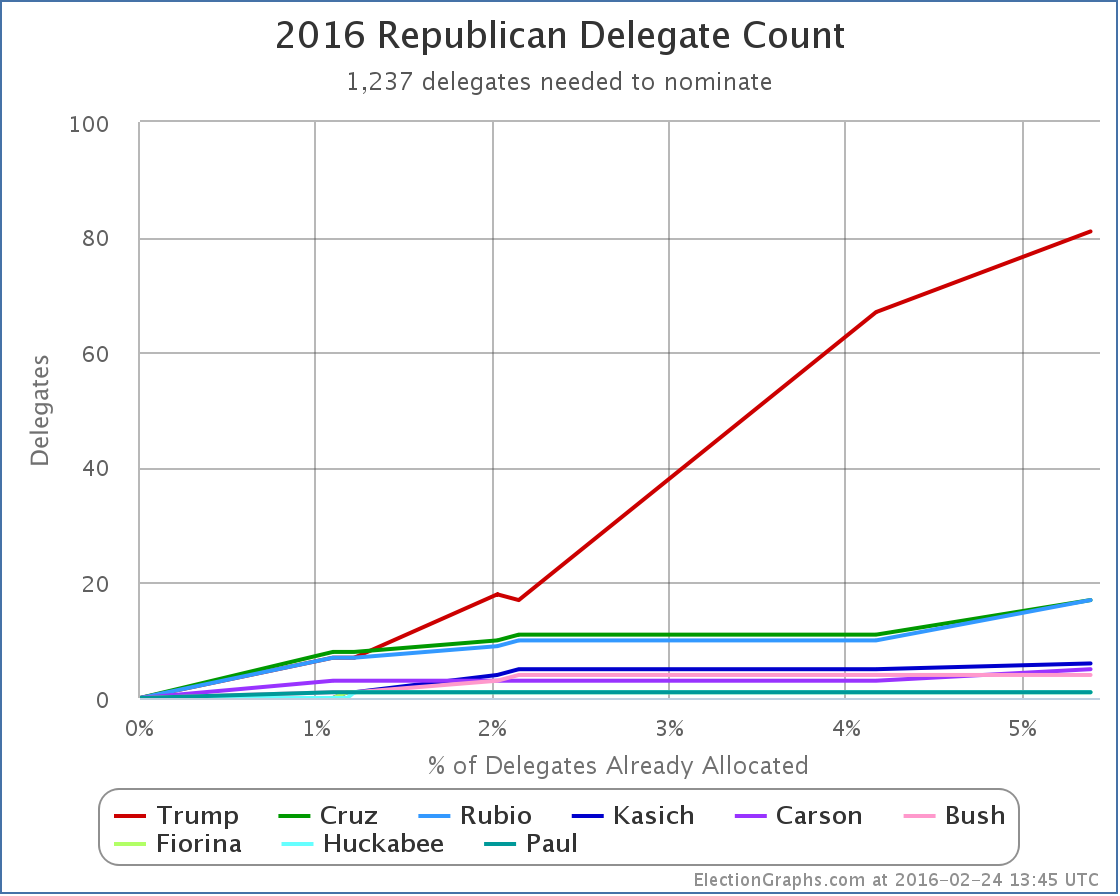
The overall delegate count is now:
81 Trump, 17 Cruz, 17 Rubio, 6 Kasich, 5 Carson, and 7 for people who have dropped out
Trump continues to dominate. Lets look at this as percentages:
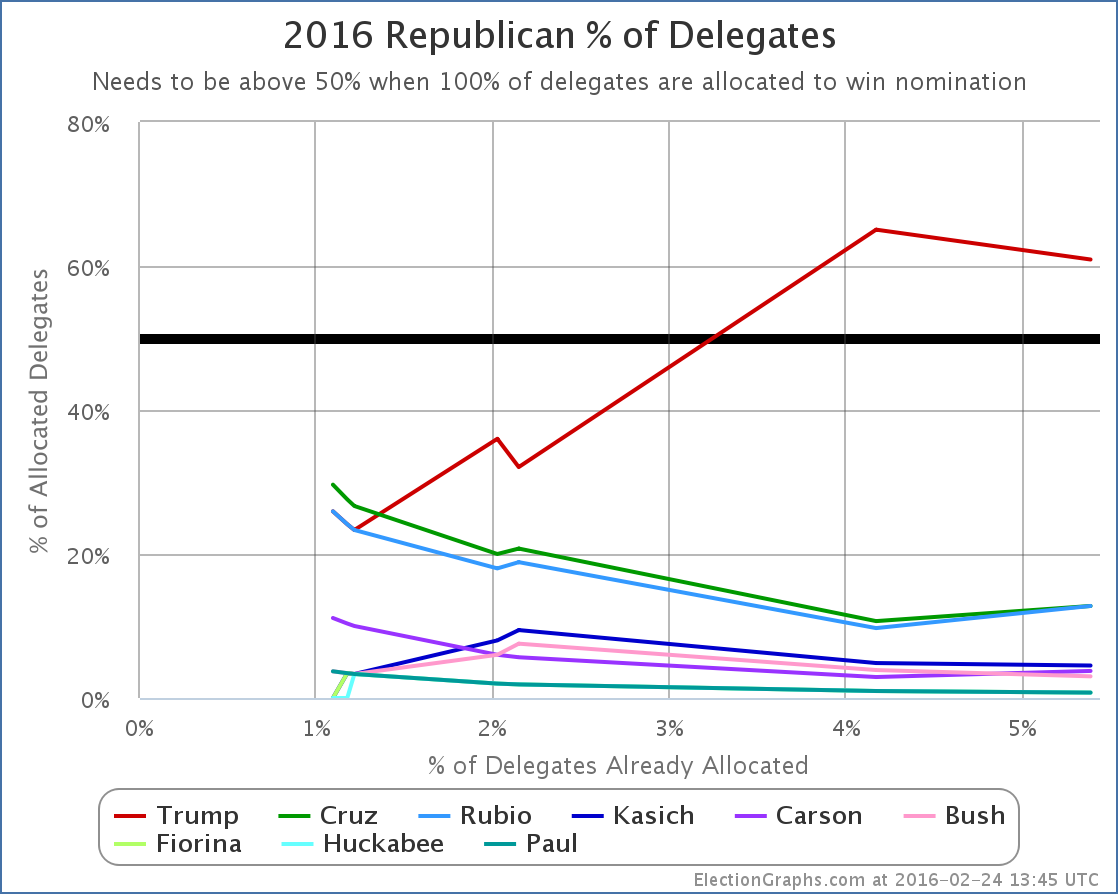
The “winners” here were actually Cruz, Rubio and Carson. Each of them improved their proportion of delegates with Nevada’s results. Trump actually went down. He doesn’t have to worry too much about that though. He still has a majority of the delegates allocated so far, and he is far far ahead of any of his opponents.
Finally, lets look at the “% of remaining delegates needed to win”, which I argue is the single most important thing to look at to understand where the race really is:
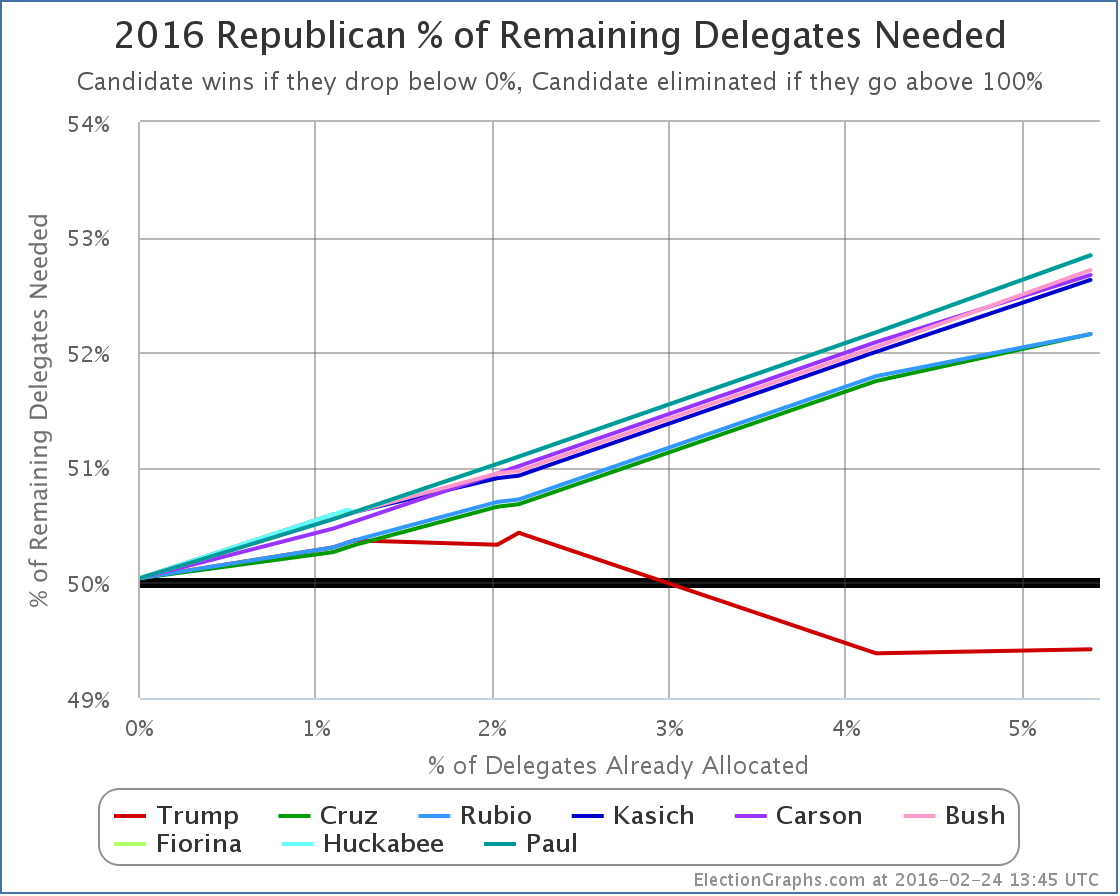
Because Trump got 14 delegates instead of 15 delegates, his line goes up a little bit. (Remember, on this chart down is good, up is bad.) The red line goes from needing 49.39% of the remaining delegates to needing 49.42%. This is a relatively trivial difference though. It is basically flat. Trump’s situation is very close to unchanged.
Meanwhile, the other lines keep going up at a decent pace. Kasich and Carson add about 0.6% to their numbers. Cruz and Rubio add about 0.4%.
This should be obvious, but the more they lose, the harder it is to catch up.
Many people are still talking about how as consolidation happens, the remaining non-Trumps will do better and the picture will change. Maybe, but nobody new announced they were dropping out after the Nevada results (yet anyway). So it looks like we may still go into March 1st with a five person race.
Lets run a hypothetical using current polling on the Super Tuesday states and see where we end up using RCP poll averages for the five remaining candidates. We’ll make delegate estimates based on the specific delegate allocation rules in each state.
Texas (155 delegates)
- Current poll averages: 37.3% Cruz, 28.0% Trump, 11.7% Rubio, 4.7% Carson, 3.0% Kasich
- Delegate estimates: 99 Cruz, 56 Trump
Georgia (76 delegates)
- Current poll averages: 35.0% Trump, 22.7% Cruz, 19.3% Rubio, 7.3% Carson, 6.3% Kasich
- Delegate estimates: 50 Trump, 26 Cruz
Tennessee (58 delegates)
- Last poll from November so using national average: 33.6% Trump, 20.4% Cruz, 16.4% Rubio, 9.8% Kasich, 7.4% Carson
- Delegate estimates: 37 Trump, 21 Cruz
Alabama (50 delegates)
- Last poll from December so using national average: 33.6% Trump, 20.4% Cruz, 16.4% Rubio, 9.8% Kasich, 7.4% Carson
- Delegate estimates: 32 Trump, 18 Cruz
Virginia (49 delegates)
- Using only February poll: 28% Trump, 22% Rubio, 19% Cruz, 7% Kasich, 7% Carson
- Delegate estimates: 17 Trump, 13 Rubio, 11 Cruz, 4 Kasich, 4 Carson
Oklahoma (43 delegates)
- Using only February poll: 32.5% Trump, 25.0% Cruz, 15.5% Rubio, 7.0% Carson, 0.0% Kasich
- Delegate estimates: 17 Trump, 15 Cruz, 11 Rubio
Massachusetts (42 delegates)
- Current poll averages: 41.0% Trump, 17.0% Rubio, 10.0% Cruz, 7.5% Kasich, 3.5% Carson
- Delegate estimates: 23 Trump, 9 Rubio, 6 Cruz, 4 Kasich
Arkansas (40 delegates)
- Using only February poll: 27% Cruz, 23% Trump, 23% Rubio, 11% Carson, 4% Kasich
- Delegate estimates: 18 Cruz, 13 Rubio, 9 Trump (giving Rubio the 2nd place finish breaking 23% tie by alphabetical order)
Minnesota (38 delegates)
- Last poll from January so using national average: 33.6% Trump, 20.4% Cruz, 16.4% Rubio, 9.8% Kasich, 7.4% Carson
- Delegate estimates: 18 Trump, 11 Cruz, 9 Rubio
Wyoming (29 delegates)
- No polls at all, using national average: 33.6% Trump, 20.4% Cruz, 16.4% Rubio, 9.8% Kasich, 7.4% Carson
- Delegate estimates: 12 Trump, 7 Cruz, 5 Rubio, 3 Kasich, 2 Carson
Alaska (28 delegates)
- Last poll from January so using national average: 33.6% Trump, 20.4% Cruz, 16.4% Rubio, 9.8% Kasich, 7.4% Carson
- Delegate estimates: 13 Trump, 8 Cruz, 7 Rubio
Vermont (16 delegates)
- No polls at all, using national average: 33.6% Trump, 20.4% Cruz, 16.4% Rubio, 9.8% Kasich, 7.4% Carson
- Delegate estimates: 10 Trump, 6 Cruz
OK, that’s it. Adding all that up…
Estimated Super Tuesday delegate totals: 294 Trump, 246 Cruz, 67 Rubio, 11 Kasich, 6 Carson
That gives Trump 47.1% of the super Tuesday delegates, Cruz 39.4%, and everyone else much less.
Trump needs 49.4% of the delegates to be on the path to an outright win though! So 47.1% would be in the realm where heading to a contested convention might be possible! Still unlikely, as the additional states in March will add up fast, and more candidates are likely to drop out. Still though, possible!
Adding in the existing delegates, we’d have a post-Super Tuesday race that looks like this:
375 Trump, 263 Cruz, 84 Rubio, 17 Kasich, 11 Carson, 7 for candidates who have already dropped out
Now, these are estimates based on current polling, and very few of these states were well polled as of this post, so much of the above is based on one or two polls, or using the national averages rather than state polls. And I had to make the assumption that all congressional districts would mirror state results (which is unlikely to be true). And Wyoming actually elects individual delegates rather than doing things based on candidate preference, so it may be an oddball in the end. And of course things are likely to change further before people actually vote next Tuesday. But… the general outlines of this aren’t likely to be too far off.
If this is even remotely close to where we are on March 2nd, we end up with Trump very close to the 50% of delegate mark. (The above has him EXACTLY at that mark.) He would need just a LITTLE bit more to actually push him over the edge to a clean win.
The flip side of that though is the combination of all the anti-Trumps would need just a LITTLE bit more in order to have this be on the path to a contested convention. I mentioned earlier that this is still an unlikely outcome. It is. After March 1st, the disproportionality of delegates given to the winner increases, and after March 15th we have pure winner take all states as well. If Trump remains in the overall lead, even with a plurality, then that is all it takes to push him over the edge.
If the anti-Trumps want to have any hope here at all, they need to be in a position by mid-March that they can win not just a few, but many states of the winner-take-most and winner-take-all variety. And frankly, the most likely scenario even then is just forcing a contested convention where Trump still has the most delegates, not someone else winning outright.
The anti-Trumps would have a hard road to get to an outright win. Cruz would need 56.8% of the remaining delegates to catch up and win after March 1st if things played out like my estimates above.
If you had to make a guess based on what we know now, a Trump nomination is far more likely than any other… and with an outright delegate majority on the first ballot, not after a contested convention.
6 days until Super Tuesday. We’ll see how close my estimates above turn out to be.
Update 2016-02-26 07:17 UTC – On February 22nd New Hampshire certified the results of their primary. In the final tally Trump had one more delegate than previous estimates, and Rubio one less. This did not seem worthy of a separate post, but a note here seemed appropriate. The totals on ElectionGraphs.com have been updates appropriately. This does not substantively change any of the analysis above.
Note: This post is an update based on the data on ElectionGraphs.com. Election Graphs tracks both a poll based estimate of the Electoral College and a numbers based look at the Delegate Races. All of the charts and graphs seen in this post are from that site. Additional graphs, charts and raw data can be found there. All charts above are clickable to go to the current version of the detail page the chart is from, which may contain more up to date information than the snapshots on this page, which were current as of the time of this post. Follow @ElectionGraphs on Twitter or like Election Graphs on Facebook to see announcements of updates or to join the conversation. For those interested in individual general election poll updates, follow @ElecCollPolls on Twitter for all the polls as they are added.
[Edit 16:28 UTC to correct math on % of remaining Cruz would need after Super Tuesday, I’d originally shown a higher number around 61%.]
[Edit 2016-02-27 17:06 UTC to fix place where Kasich had been autocorrected to Quash.]
[Edit 2016-02-28 22:03 UTC to add dropped out candidates to the after Super Tuesday estimate.]
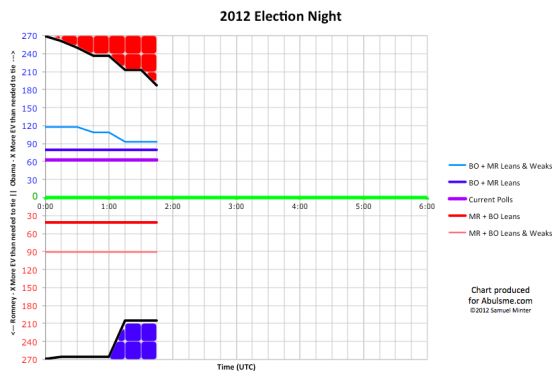
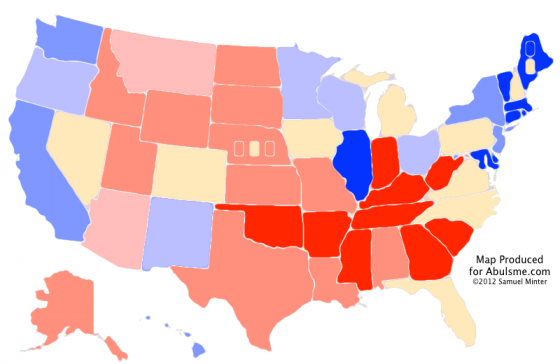
|
Romney |
Obama |
| Romney Best Case |
310 |
228 |
| Current Status |
206 |
332 |
| Obama Best Case |
190 |
348 |
There were no new calls between 01:15 UTC and 01:30 UTC.
Between 01:30 UTC and 01:45 UTC, Arkansas, Tennessee and Alabama were all called for Romney… as expected.
At some point they will need to start calling some of the close states, or it will be a really long night. :-)
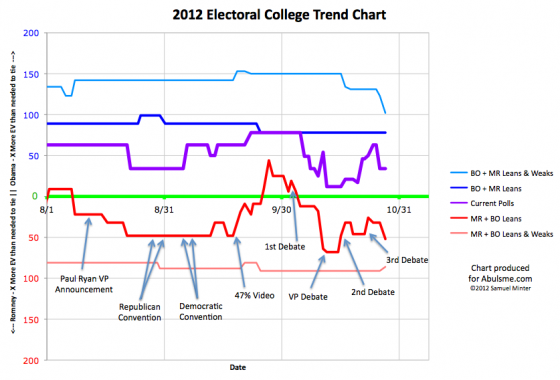
Four states change status today, three moving toward Romney, one moving toward Obama. On the surface this looks very good for Romney. We’ll look into why that might not be the case in a bit, but first lets look at the four states that move today:
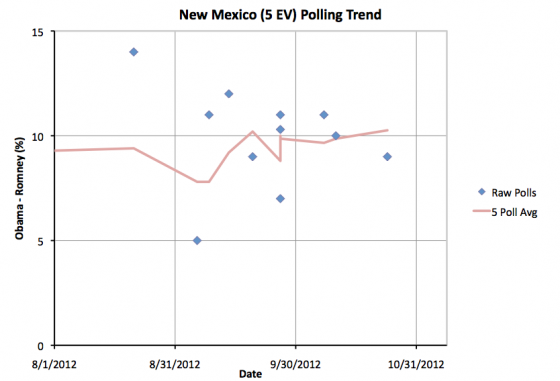
Very little to say about New Mexico. Obama’s lead increases slightly and is now over 10%. Obama will win New Mexico.
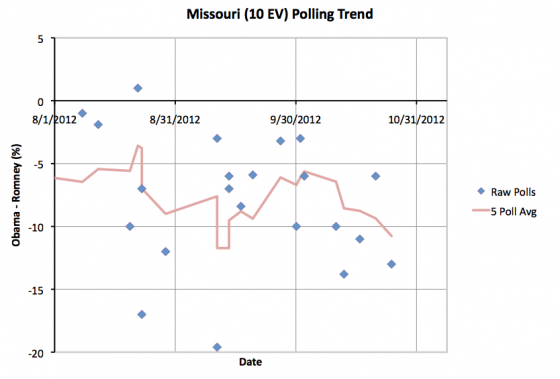
Not much to see in Missouri either. Romney’s lead increases slightly and is now over 10%. Romney will win Missouri.
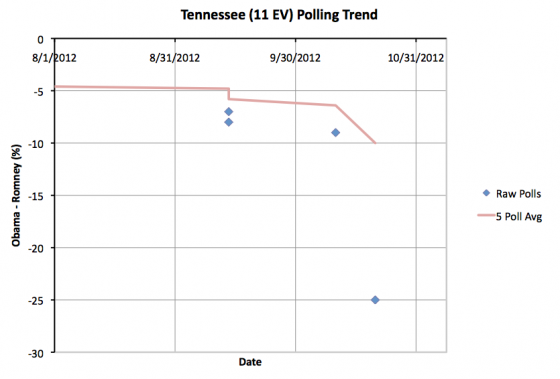
Tennessee is a bit odder. The new poll showing a 25% Romney lead in Tennessee looks like an outlier. No other poll in the state from the last year shows a Romney lead greater than 9%. Without this poll the five poll average has a Romney lead of 6.4%. With this, the Romney lead jumps to 10.0%, which moves Tennessee to the “Strong Romney” category. This may not be deserved, but I don’t make judgements about outliers, I just let the average sort it out. Either way, Tennessee’s not in contention this year. Romney will win Tennessee.
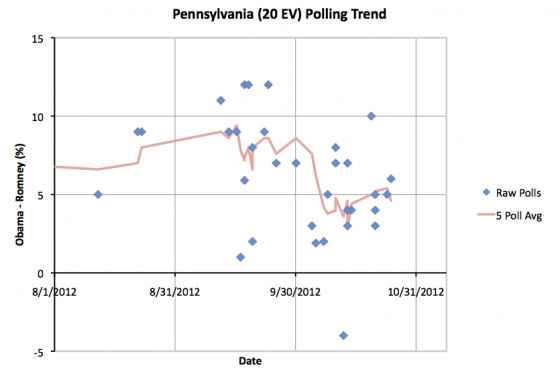
Pennsylvania shows Obama’s lead dropping under 5% again as an outlier showing Obama leading by 10% drops off. Again, we just let the average deal with outliers here, and that is what has happened. Pennsylvania returns to “Lean Obama” which probably better represents the true state of the race in Pennsylvania at the moment. Having said that, it is at the high end, Obama’s lead in the five poll average is now 4.6%. This is a pretty substantial lead. Any scenario that has Romney winning Pennsylvania would already have him wining the presidency handily.
OK, so this gives us this new map and summary:
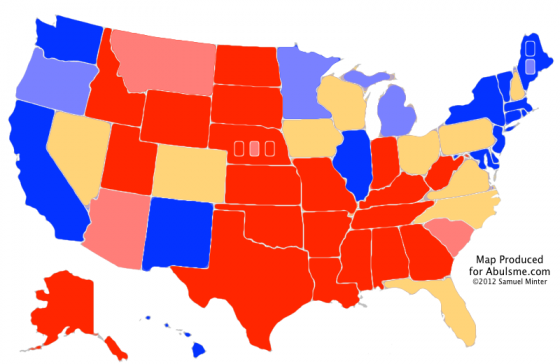
|
Romney |
Obama |
| Romney Best Case |
321 |
217 |
| Current Status |
235 |
303 |
| Obama Best Case |
191 |
347 |
As before though, since depending which way the close states go you could have either candidate winning, we need to look at the individual states:
- North Carolina (15 ev): 2.4% Romney lead – 4/5 polls after last debate
- Florida (29 ev): 0.8% Romney lead – 5/5 polls after last debate
- Virginia (13 ev): TIE – 5/5 polls after last debate
- Iowa (6 ev): 1.2% Obama lead – 2/5 polls after last debate
- New Hampshire (4 ev): 2.2% Obama lead – 2/5 polls after last debate
- Colorado (9 ev): 2.8% Obama lead – 5/5 polls after last debate
- Nevada (6 ev): 2.8% Obama lead – 5/5 polls after last debate
- Ohio (18 ev): 3.1% Obama lead – 5/5 polls after last debate
- Wisconsin (10 ev): 3.8% Obama lead – 3/5 polls after last debate
- Pennsylvania (20 ev): 4.6% Obama lead – 2/5 polls after last debate
Something interesting here, but I am running out of time to go into detail. Ohio is no longer the tipping point state! If you start adding these states up in order of how far away they are from Romney, you see that Romney’s clearest path to victory is now holding North Carolina and Florida, then pulling ahead and winning Virginia, Iowa, New Hampshire, Colorado and Nevada. If he does that, he wins 273 to 265.
So as of today, if he moves every state more than 2.8% toward him, Romney wins. But yesterday that percentage was 2.5%. Wednesday it was 1.6%. Tuesday it was 1.2%
I may make a spiffy graph of this with the next update, but for now just looking at those numbers, you can see that despite moving some states closer to him, Romney’s path to victory is slipping away. The states he needs to pull ahead in are instead slowly pulling away.
Note: Chart and map from the Abulsme.com 2012 Electoral College Prediction page. Both assume Obama vs Romney with no strong third party candidate and show polling as it currently exists. Things will change before election day. On the map red is Romney, blue is Obama, gold states are too close to call. Lines on the chart represent how many more electoral votes a candidate would have than is needed to tie under several different scenarios. Up is good for Obama, Down is good for Romney.
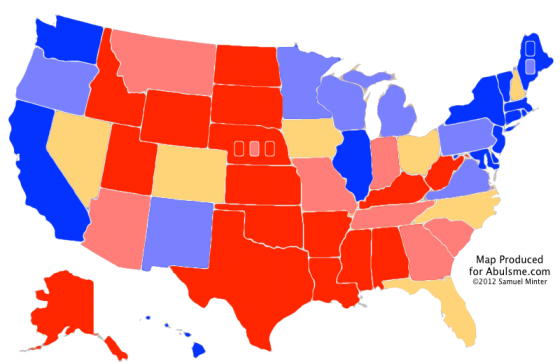
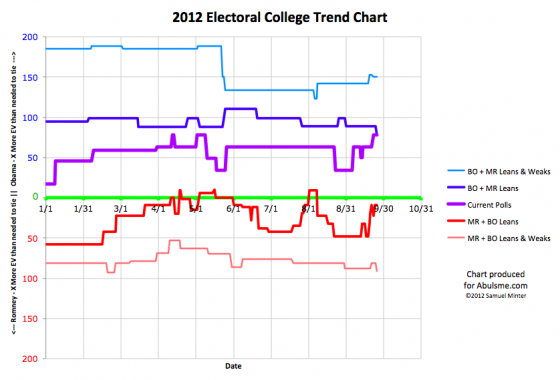
Two changes in category today, and bucking the recent trend, they are both moves toward Romney. In reverse order of electoral college weight:
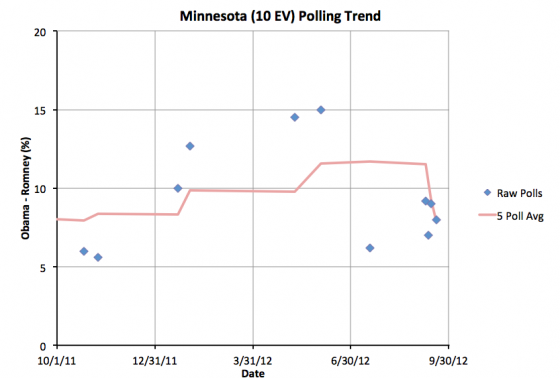
Minnesota (10 electoral votes) had been pretty sparsely polled before the conventions, and the five poll average had shown an Obama lead as high as 11.7% in July. With the batch of new polling in September, Obama’s lead has now dropped to only 7.9%. “Only” is of course relative. 7.9% is still a pretty substantial lead. Minnesota is not in play right now. The only question is how much Obama is going to win by. It looks like Obama’s margin will be less than it once looked like it might be. But this should still be an easy win for Obama.
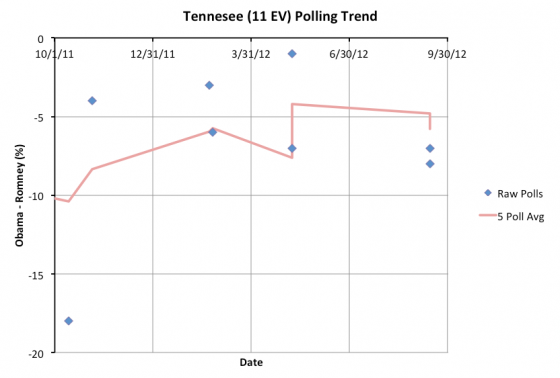
Tennessee (11 electoral votes) is another state that hasn’t been polled all that often. The last set of polls, back in May, had moved the five poll average to a Romney lead of less than 5%, specifically a 4.2% lead. That had put Tennessee into the set of states my model thought could go either way. After all, a 4.2% lead is pretty slim. The right set of things happening, and perhaps Obama could have actually taken the lead there.
Well, the new set of polls added this week, which are actually two related results from YouGov, moves the average to a 5.8% Romney lead. As far as my model is concerned, that pulls Tennessee out of reach for Obama. Tennessee always seemed like a big stretch for Obama. It always seemed a bit odd that it was showing up in the “close states” category. Well, it now resumes a more natural looking position as a “Weak Romney” state, meaning that Romney has a big lead there, but maybe not so big a lead that he should completely ignore it.
Of course it will get ignored, because Obama doesn’t need it to win. Any scenario that has Obama winning Tennessee is probably an Obama landslide. So Obama isn’t going to pay attention to it. Meanwhile, if Romney is in a position where he is really fighting to win Tennessee, he has already lost. Given he is way behind right now, he needs to be concentrating on states where Obama is ahead to try to bring them back over to his side of the line. Spending time shoring up a state like Tennessee would be a waste of resources for Romney too. So, no attention for Tennessee. Poor Tennessee.
So where does this put the summary? Minnesota has no effect because it was never close. I no longer consider winning Tennessee to be a possibility for Obama, so Obama’s “best case” gets a little worse:
|
Romney |
Obama |
| Romney Best Case |
278 |
260 |
| Current Status |
191 |
347 |
| Obama Best Case |
191 |
347 |
The interesting thing here is of course that the current status is now the same as Obama’s best case. This is because there are no longer ANY close states where Romney is ahead. Tennessee is no longer close because it is now more solidly Romney. So that is good for Romney. Two states moved TOWARD Romney today. This is GOOD for Romney compared to yesterday.
But the overall situation remains very very difficult.
The remaining close states… Florida (29), Ohio (18), North Carolina (15), Colorado (9), Iowa (6), Nevada (6), and New Hampshire (4)… are all states where Obama is ahead.
Now, all of those states are close, and some of them are very close, with Obama’s lead no more than a sliver. Romney could retake the leads in one or more of these states with a little bit of a good news cycle and just one or two good polls.
But what this effectively does is put Obama at his ceiling. Previously, there was headroom above the “current” situation. You could imagine Obama doing a bit better and moving one or more states that were close but leaning Romney to being close but leaning Obama. Now there are no more Romney states that are close… states that one could easily imagine Obama picking up.
To do any better than a 347 to 191 win… which is where the state by state polls put him right now… Obama would need to start picking up states where Romney is ahead by more than 5% (but ones where he is ahead by less than 10%, because we need to retain at least some realism).
The areas in this category are now Georgia (16), Arizona (11), Indiana (11), Tennessee (11), Missouri (10), South Carolina (9), Montana (3) and Nebraska’s 2nd Congressional District (1). With the possible exception of Nebraska’s 2nd, which is very infrequently polled but where a poll this week showed the race tied, all of these seem like BIG stretches right now. Even if Romney collapses further and Obama expands his national lead, one could maybe see some of these getting closer again, but they have a long way to go to actually end up in the Obama win column.
As he was looking at the wiki between my update there and this post, a reader asked a question: Has this happened before?
I knew it hadn’t happened in this cycle, but I had a vague memory of there being some time in 2008 where all the close states were leaning in one direction. But I was wrong. Looking at my 2008 analysis, this didn’t happen then either. (I wasn’t doing this in 2004 or before, so I can’t speak to those years.) So indeed,with my method of classifying states… with leads in a five poll average less than 5% being considered “close” states that could go either way… this is the first time in two election cycles where ALL of the “close” states have leaned toward one candidate.
The positive spin for Romney is that Obama has reached a top. It will be very hard for him to do any better in the electoral college than where things are right now.
Of course, the flip side of that is that at the moment Obama is pretty far ahead, and to win Romney has to win almost all of the close states… all of which he is behind in at the moment.
This is not where a candidate wants to be in late September.
It isn’t quite time to just call the race for Obama and go home.
But it is getting close.
Last time around I “called the race” on October 3rd. In 2008 that was the first time we had a situation where McCain’s “best case” in my model was still losing. I didn’t actually think that situation would be sustained through November, but it the end it was. From October 3rd onward, the state by state polls showed a clear Obama win.
This time around, Romney has already been in that “best case is to lose” situation in my model three times. Each time he has recovered, but if Obama increases his lead in one or two key states, he could end up there again pretty easily. Unlike the last three times, there will be very little time to recover if he falls that far behind again. Of course, he would have to not just improve from that point, he would have to get to a point better than he has been at any time this year to actually pull into the lead.
At this very moment, his “current” line is well behind where McCain’s was four years ago too. Four years ago today it looked like McCain would get 256 electoral votes if the election was held then. That wasn’t enough to put him in the lead of course, but it was a lot better than the 191 Romney has in his column at the moment.
Romney needs some major game changing event to make this an interesting race again. He is running out of time for it.
He must wake up every day hoping that Obama will make some major mistake. Instead though, in the last few weeks anyway, it seems like it is Romney putting his foot in his moth over and over again. That isn’t what he needs to be able to start closing the gap, let alone to take the lead.
Note: With a new poll that I added to my spreadsheet today, the date that Wisconsin moved from Lean Obama to Weak Obama shifts from September 20th to September 21st. The trend chart at the top of this post reflects that adjustment.
Note: Chart and map from the Abulsme.com 2012 Electoral College Prediction page. Both assume Obama vs Romney with no strong third party candidate and show polling as it currently exists. Things will change before election day. On the map red is Romney, blue is Obama, gold states are too close to call. Lines on the chart represent how many more electoral votes a candidate would have than is needed to tie under several different scenarios. Up is good for Obama, Down is good for Romney.
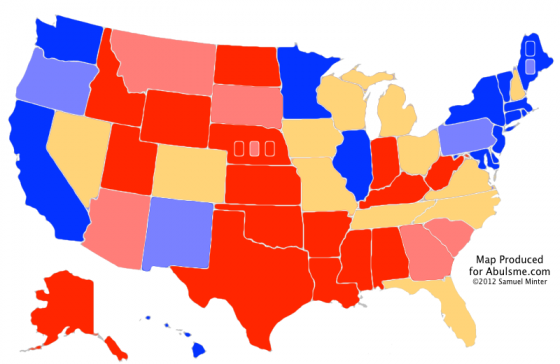
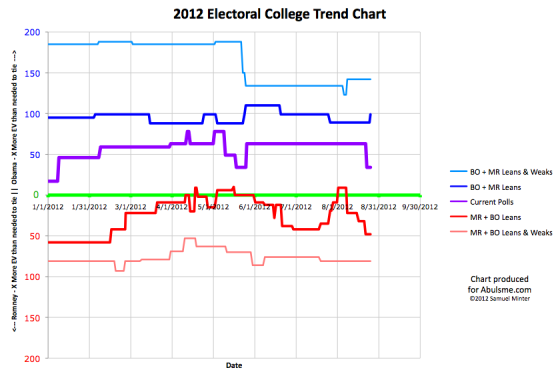
One change in this update, and for the first time in more than two weeks it is a move in Obama’s direction.
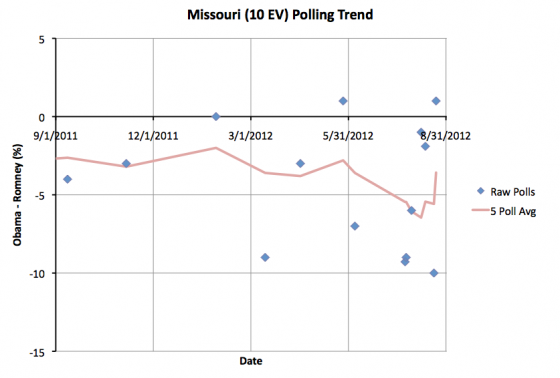
The state that moves this time is indeed Missouri (10 ev), the location of the recent dustup about comments made by Todd Akin. Could some of that be spilling into the presidential poll numbers? Well, I’d be reluctant to say that quite yet. Two of the five polls in the five poll average were taken after the incident last weekend. A PPP poll on the 20th showed Romney up 10% in Missouri. Then a Rasmussen poll on the 22nd showed Obama up 1%. Now, perhaps that was real movement caused by the coverage going on in those days. Or not. The two polls are just not enough to get a good grasp on that.
The addition of the latest poll does drop Romney’s lead in the state in my average to 3.6% though, which is enough to call the state close again. While Obama is still behind here, it is now close enough that putting some effort into trying to win it doesn’t seem completely unreasonable. Having said that, despite a few scattered polls showing Obama leads, Obama has never been ahead here in the five poll average. Obama winning Missouri is unlikely absent large moves nationally pushing toward an Obama landslide.
This does improve what I call Obama’s “best case”:
|
Romney |
Obama |
| Romney Best Case |
317 |
221 |
| Current Status |
235 |
303 |
| Obama Best Case |
170 |
368 |
Obama’s best case now actually exceeds his 2008 results (a 365 to 173 victory). This would require a sweep of all of the close states though, including the ones he is behind in at the moment. That would be Florida (29 ev), North Carolina (15 ev), Tennessee (11 ev) and Missouri (10 ev). In the five poll average at the moment, Romney is ahead by 3.5% in Florida, 0.6% in North Carolina, 4.2% in Tennessee and 3.6% in Missouri.
I’ve always said that a lead less than 5% can disappear overnight with the right events in the news, but still, it is hard to imagine at the moment the kind of news that would get Obama all four of these states.
Florida has bounced back and forth all year. It is easy to imagine it going either way.
North Carolina is more of a stretch. Obama has sometimes been in the lead there, but most of the time Romney has been. But maybe if things go very well for Obama he will manage North Carolina.
Tennessee and Missouri though? Obama has never been ahead in those states. Obama taking leads in either states would be indicative of a huge Romney collapse.
The Republican convention is starting in a few days though. So don’t expect many moves in Obama’s direction in the short term. Unless the convention is a huge disaster, it is much more likely we see more movement toward Romney from now until the Democratic Convention gets under way.
Note: Chart and map from the Abulsme.com 2012 Electoral College Prediction page. Both assume Obama vs Romney with no strong third party candidate and show polling as it currently exists. Things will change before election day. On the map red is Romney, blue is Obama, gold states are too close to call. Lines on the chart represent how many more electoral votes a candidate would have than is needed to tie under several different scenarios. Up is good for Obama, Down is good for Romney.
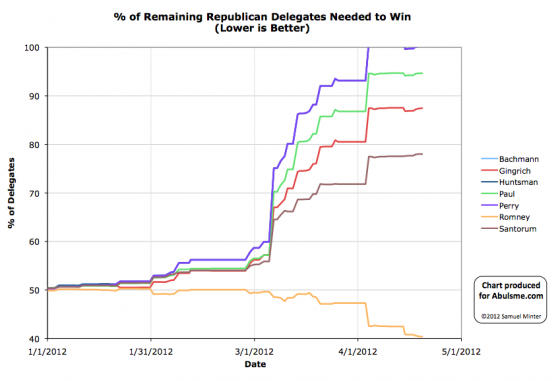
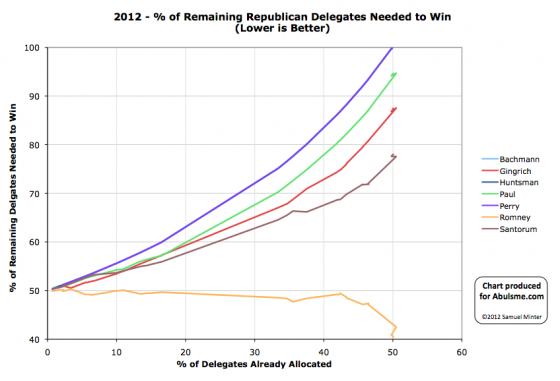
Charts from the Abulsme.com 2012 Republican Delegate Count Graphs page. When a candidate gets down to 0%, they have clinched the nomination. If they get above 100%, they have been mathematically eliminated. The first chart is by date, the second is by “% of Delegates Already Allocated”. These numbers include estimates of the eventual results of multi-stage caucus processes which will be refined as the later stages occur.
Another minor update as Green Papers gets final delegate numbers from Tennessee. Back in March the results from the Primary were reported as Santorum 29, Romney 16, Gingrich 10. The final results turned out to be Santorum 29, Romney 17, Gingrich 9.
So for the day: Romney +1, Gingrich -1
In terms of “% of remaining delegates needed to win”:
- Romney: 40.5% -> 40.4%
- Santorum: 78.0% (No Change)
- Gingrich: 87.4% -> 87.5%
- Paul: 94.7% (No Change)
Can we please have some primaries again? This slow dripping of minor delegate changes is killing me. :-)
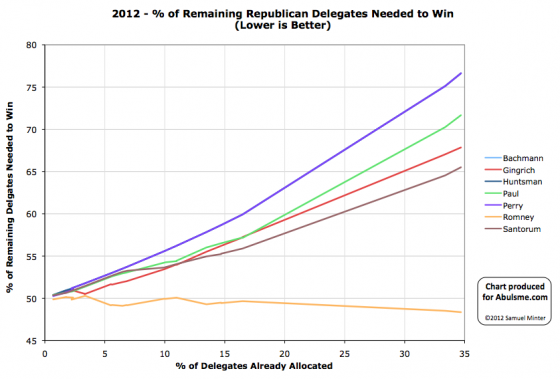
Chart from the Abulsme.com 2012 Republican Delegate Count Graphs page. When a candidate gets down to 0%, they have cinched the nomination. If they get up past 100%, they have been mathematically eliminated. Rather than the date on the x-axis, we show the “% of Delegates Already Allocated” as this better represents the progress through the race. Note that these numbers include estimates of the eventual results of multi-stage caucus processes which will be refined as the later stages occur.
So it appears that the last 34 delegates from Super Tuesday, a handful each from Georgia, Ohio and Tennessee, have been determined. 17 more to Romney, 8 more to Gingrich and 5 more to Santorum. But wait, that is only 30! Well, according to Green Papers, 4 of the 63 delegates that were up for grabs in Ohio end up officially “Uncommitted”, which (I think) means we won’t actually know which way they may go until we know which actual human beings end up being those delegates and those people say publicly who they plan on supporting (which they may or may not actually do before the convention).
All in all, today’s results are once again a win for Romney. He got 56.7% of today’s delegates, which was way more than the 48.5% he needed to continue to move closer to the nomination rather than further way. His “% of remaining needed to win” drops now to 48.4%. For the other candidates, the effect on the other side is more dramatic. Santorum is still in 2nd place, but his “% of remaining needed to win” moves up from 64.5% to 65.5%. Romney may not yet be rapidly moving toward cinching the nomination, but the non-Romneys are rapidly moving toward being mathematically eliminated.
Looking at the non-Romney’s for a minute, the next few states are expected to favor them. Perhaps Santorum will win some. Perhaps Gingrich will win some. But to actually be on a pace to win, Santorum has to not just win a state, but win by a huge margin, getting more than 65.5% of the delegates. For Gingrich it is even worse, he would need to win getting 67.8% of the delegates. (For completeness, Paul would need to get more than 71.7%.)
Even with Romney expected to not be strong in these states, with four candidates in the race, you don’t expect anybody to be able to pull that kind of level except in winner take all (or winner take almost-all) states. Of the next few coming up… in Kansas, Guam, Northern Marianas, Virgin Islands, Alabama, Mississippi, Hawaii and American Samoa there are as usual complicated delegate rules (and the territories might only select uncommitted delegates), but none of them are straight up winner takes all. (Some allow for certain situations that could lead there though.) Bottom line, 65.5% (or more) is a pretty big ask and seems unlikely.
Which means that even if Santorum or Gingrich win some states (as expected) in terms of delegates they will almost certainly still both be heading closer to mathematical elimination rather than closer to the nomination. The big thing to look at will once again be looking at how well the non-Romney’s collectively block Romney from getting the 48.4% of the delegates he needs to be closing in on the nomination himself. With strong performance by the non-Romney’s in the next few contests, they may well be able to achieve this, even if they don’t actually help themselves individually.
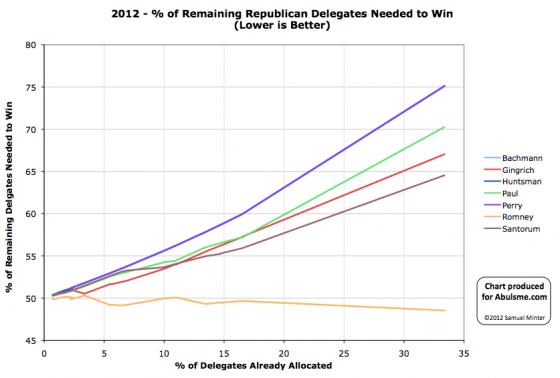
Chart from the Abulsme.com 2012 Republican Delegate Count Graphs page. When a candidate gets down to 0%, they have cinched the nomination. If they get up past 100%, they have been mathematically eliminated. Rather than the date on the x-axis, we show the “% of Delegates Already Allocated” as this better represents the progress through the race. Note that these numbers include estimates of the eventual results of multi-stage caucus processes which will be refined as the later stages occur.
So, Super Tuesday happened. As of this update, Green Papers has “called” 385 of the 419 delegates available from the Super Tuesday contests. There are 34 delegates that haven’t been determined yet that will result in updates later, but of the ones we do know, the estimates for Super Tuesday contests are: Romney 208, Santorum 84, Gingrich 72, Paul 21. Romney also picked up a Superdelegate, bringing the total for the day to Romney 209, Santorum 84, Gingrich 72, Paul 21.
Compared to the Sabato Crystal Ball projections which we used to game out Super Tuesday over the weekend, Romney performed better than expectations, as did Gingrich. Santorum and Paul underperformed compared to those predictions. In any case, where does this put us…
Bottom line, Romney is the big winner today, and this may be the start of him actually pulling away and heading toward the nomination, but he is still not out of the woods in terms of the danger of being blocked from 1144. Lets look at the details.
The situation for Santorum, Gingrich and Paul is essentially what I mapped out in the gaming Super Tuesday post. To paraphrase what I said there, it is now absolutely undeniably clear (although the trend was obvious even before today) that none of these three guys are on a path to the nomination. Of the three, Santorum is doing the best, but with today’s numbers, to be on a path to win, he would need to now get 64.5% of the remaining delegates, compared to the 21.1% he has gotten so far. For this to even come into the realm of possibility, Gingrich and Paul would both have to stop getting delegates, Santorum would have to pick up all of their support, AND something would need to happen to cause support for Romney to plummet. This is a very unlikely sequence of events. It isn’t going to happen.
Oh, I guess I should also note that Gingrich pulled back ahead of Paul for 3rd place.
The remaining question is: “Are the non-Romney’s collectively still in a position to potentially block Romney from getting to 1144?” If after today, Romney was under 50% of the total delegates, and his “% of remaining needed to win” was heading upward or flat, this is a possibility that would be looking like it was still very much in play. But Romney exceeded the 49.7% of delegates he needed in order to be on track toward 1144, and did it by a decent margin. Of the delegates in today’s total, he picked up 209 of 386, or 54.1%. This reduced his “% of remaining needed to win” from 49.7% to 48.5%. That means to block, the non-Romney’s collectively need to be getting 51.5% of the delegates, compared to the 46.9% they have managed so far. So they have to do better than they have been so far, and by a non-trivial margin. And they have do do this even though it is obvious none of them can win outright. It has to be about stopping Romney.
Now, the rest of March has a bunch of states that are supposed to be relatively good for the non-Romneys. So the non-Romney’s managing to get 51.5% in the next few state is very much within the realm of possibility. After that we hit more Romney friendly states in April. The thing to watch for in the upcoming states is not who wins the popular vote, or even the delegate count. The question will be: “Is Romney continuing to get enough delegates to avoid being blocked?” Right now, that magic number is 48.2%. As long as he is getting 48.2% of the delegates (or more) then he is marching his way toward the nomination. If he gets less than that, then blocking will remain possible a little bit longer. If the rest of March really is friendly to the non-Romneys, we may see that Romney’s “% needed to win” starts heading back up a bit before Romney hits friendly states again and starts fully pulling away. As long as we see that happening, blocking Romney is still a possibility. And indeed, if Romney is damaged by the contests in March and his April states start looking not so good after all, then blocking starts looking more real again.
But Romney’s “% of remaining needed to win” is the smallest it has been so far, and none of the other candidates have realistic shots at winning, only a shot at blocking that relies on them continuing to win delegates even though it is obvious they can’t win, so Romney is in a pretty good position right now. Watch that line though. Until it starts heading downward decisively, Romney hasn’t got it wrapped up just yet.
So what is next? Well, first, the last 34 delegates from Super Tuesday (they are from Georgia, Ohio and Tennessee). Then on Sunday we have Kansas (40), Guam (9), Northern Marianas (9), Virgin Islands (9). Then Tuesday we have Alabama (50), Mississippi (40), Hawaii (20), American Samoa (9). And then it goes on and on…
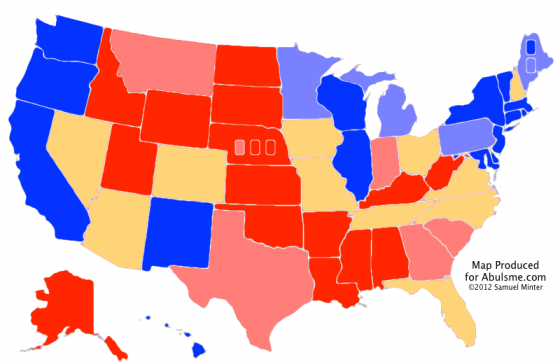
Map from the Abulsme.com 2012 Electoral College Prediction page. This map reflects Obama vs Romney. If any other candidate takes the lead in the Republican delegate race we’ll switch to making maps for them.
New polls in our last five poll averages move Obama’s lead in Wisconsin to over 10%, so that state moves into the “Strong Obama” category.
More interestingly perhaps, Romney’s lead in Tennessee drops to under 5%, moving that state to the “Lean Romney” category, which for purposes of our “best case” scenarios, puts the state into play for Obama. In 2008 McCain won Tennessee by a 15% margin, so this is somewhat surprising. We’ll see if this holds up as we move further into the year, but for the moment, that is where we are.
New Summary:
|
Romney |
Obama |
| Romney Best Case |
291 |
247 |
| Current Status |
210 |
328 |
| Obama Best Case |
159 |
379 |
And the trends since the beginning of the year…
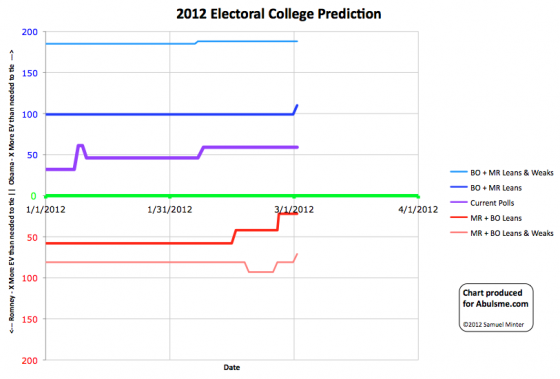
Chart from the Abulsme.com 2012 Electoral College Prediction page.
Up is better for Obama, so you can see that at least so far, things have generally been heading in his direction. It is of course still very early, so much will change between now and November.
Correction 2012 May 23 10:18 UTC: As it turns out, Wisconsin should NOT have flipped from Weak Obama to Strong Obama with this update on March 2nd. This change was influenced by the presence of a Washington State poll that I incorrectly included in my Wisconsin data. When this is backed out, Wisconsin does eventually go Strong Obama, but not until March 30th. Thanks to Darryl at HorsesAss for finding the error in my spreadsheet. The time series chart is corrected to reflect this starting with my May 23rd update.
Correction 2012 Jun 8 14:56 UTC: So, Tennessee shouldn’t have moved on this day either. The HorsesAss data included an old Tennessee poll from October 2011, that shows a strong Romney lead. The presence of this poll would have delayed the Tennessee move to “Lean Romney” until May 24th. This was noted and the historical graphs corrected starting with the June 8th update.
|
|























